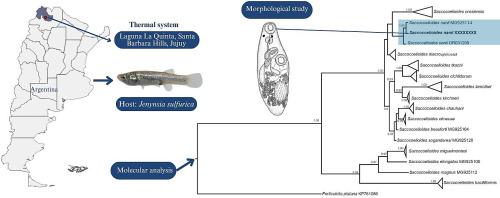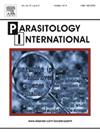纳米Saccocoelioides nanii (Digenea:单孔虫科)感染嗜极动物Jenynsia sulicica (Cyprinodontiformes: Anablepidae)首次报道
IF 1.9
4区 医学
Q3 PARASITOLOGY
引用次数: 0
摘要
报道了一种Saccocoelioides(单孔虫科),来自阿根廷西北部一个极端环境的产鱼Jenynsia sulivica(无孔虫科)的肠道。这种寄主物种生活在一个富含硫化物的热流体中,其特征是几个极端的环境条件,包括高温、低氧水平、中等pH值和高总溶解固体。形态学和分子分析表明该寄生虫与Saccocoelioides nanii一致。形态学比较显示了体型和比例的微小差异,而基于28S rDNA、COI和ITS2区域部分序列的分子分析证实了其与先前描述的nanii种群的遗传相似性。这一发现是第一次记录nans . nanii寄生于水蛭科昆虫,也是第一次发生在极端环境下。这一发现扩大了该物种已知的寄主范围和地理分布,并强调了综合形态学和分子方法在了解该群体多样性方面的重要性。本文章由计算机程序翻译,如有差异,请以英文原文为准。

First report of Saccocoelioides nanii (Digenea: Haploporidae) infecting an extremophile host, Jenynsia sulfurica (Cyprinodontiformes: Anablepidae)
A species of Saccocoelioides (Haploporidae) is reported from the intestine of the livebearer fish Jenynsia sulfurica (Anablepidae), which inhabits an extremophile environment in northwestern Argentina. This host species lives in a sulfide-rich thermal stream characterized by several extreme environmental conditions, including high temperatures, low oxygen levels, moderate pH, and elevated total dissolved solids. Morphological and molecular analyses indicate that the parasite under study is consistent with Saccocoelioides nanii. Morphological comparisons revealed minor variations in body size and proportions, while molecular analysis based on partial sequences of 28S rDNA, COI and ITS2 regions confirmed its genetic similarity to previously described S. nanii populations. This discovery represents the first record of S. nanii parasitizing a member of the family Anablepidae, and the first occurrence under extremophile conditions. This finding expands the known host range and geographic distribution of the species and highlights the importance of integrative morphological and molecular approaches in understanding the diversity of this group.
求助全文
通过发布文献求助,成功后即可免费获取论文全文。
去求助
来源期刊

Parasitology International
医学-寄生虫学
CiteScore
4.00
自引率
10.50%
发文量
140
审稿时长
61 days
期刊介绍:
Parasitology International provides a medium for rapid, carefully reviewed publications in the field of human and animal parasitology. Original papers, rapid communications, and original case reports from all geographical areas and covering all parasitological disciplines, including structure, immunology, cell biology, biochemistry, molecular biology, and systematics, may be submitted. Reviews on recent developments are invited regularly, but suggestions in this respect are welcome. Letters to the Editor commenting on any aspect of the Journal are also welcome.
 求助内容:
求助内容: 应助结果提醒方式:
应助结果提醒方式:


